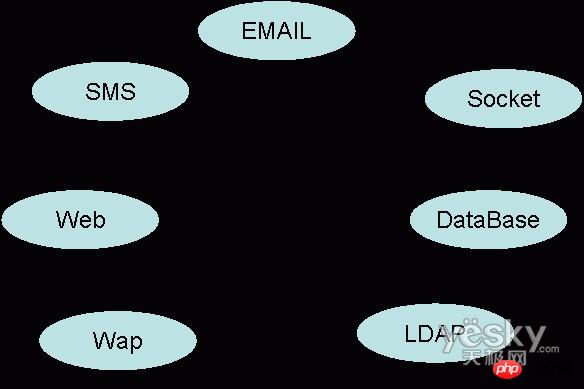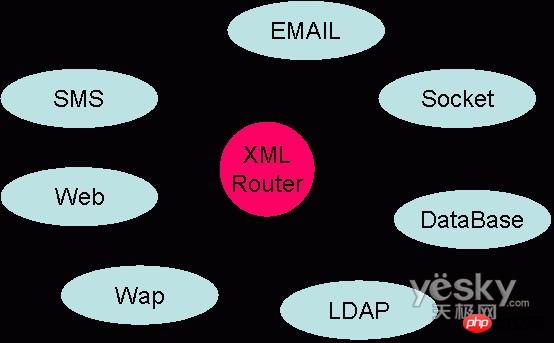XML을 사용하여 다중 채널 액세스 웹사이트의 구조를 구현하는 방법
1. 배경
오늘날의 웹사이트에는 WAP, SMS, EMAIL, 기존 웹, 소켓 등 접속 채널이 점점 더 많아지고 기술도 점점 발전하고 있습니다. 데이터베이스와 LDAP가 연결된 것으로 간주하더라도 새 채널을 추가할 때 더 이상 코드 수정이나 코드 변경이 필요하지 않도록 설계에서 확장해야 하는 공간이 매우 좋아야 합니다. 그런데 불가능할 것 같은데, 이 다중 채널 액세스 프레임워크의 완벽함을 더 잘 해결할 수 있는 방법은 없을까요?
2. 아키텍처

【그림 1】
그림 1과 같이 기존 액세스를 모두 사용했을 때 디자이너는 당황하여 공유를 얻으려면 다음과 같은 프로그램을 작성하면 됩니다. 어쨌든 구현될 수는 있지만 유지 관리가 더 어려울 것입니다. 다시 질문으로 돌아가서 어떻게 하면 그림 2에서 볼 수 있듯이

[그림 2]
그림 2는 발톱이 여덟 개인 문어처럼 생겼는데, 이 모든 채널을 연결하는 핵심이 바로 문어머리 xmlRouter이다. 여기서 라우터의 장점은 모든 채널을 통해 통신하고, 데이터 라우팅을 구현하고, 시스템 아키텍처의 확장성과 유연성을 향상시키는 것입니다. 유연하고 표준화된 언어인 XML을 데이터 전송 매체로 사용하지 않으면 라우터의 작업 부하도 기하급수적으로 증가하기 때문에 XMLRouter라고 합니다.
3. 아이디어 및 패턴
XMLRouter의 원래 아이디어는 컴퓨터 마더보드의 빌더 패턴에서 왔으며 컴퓨터 마더보드의 PCI 슬롯은 PCI 사양을 정의합니다. 제작한 카드가 PCI 표준을 준수하는 한 마더보드에 꽂으면 작동합니다. 내부 작동 방식은 빌더 패턴으로 캡슐화하여 복잡한 구성을 구현하도록 제안합니다. .XMLRouter는 이러한 복잡한 채널을 분리하여 하나씩 수행합니다.
서비스 아이디어: 라우터와 통신하려면 이러한 채널에 액세스할 때 통합 인터페이스를 정의해야 하며 이를 서비스라고 합니다. 프로그램이 서비스 사양을 준수하는 한 라우터 및 경로 데이터에 액세스할 수 있습니다.
Factory 모드 및 Composite 모드
XMLRouter는 실제 설계에서 Factory 모드를 사용하여 생성됩니다. RouterFactory Production에 의해 생성된 라우터는 사용 시 대기열에 배치되며 데이터 전송, 데이터 수신 및 데이터 반환을 위한 해당 라우터가 대기열에서 호출되고 복합 모드가 적용됩니다.
4. XML 구성 파일 XML 파일은 라우터에서 사용하기 위해 두 부분으로 나뉩니다. 첫 번째는 다음과 같은 라우터 구성입니다.<?xml version="1.0" ?> <services> <!-- database Service --> <service name="database" type="database" class="com.web.service.DBService"> <connector driver="com.microsoft.jdbc.sqlserver.SQLServerDriver" url="jdbc:microsoft:sqlserver://192.168.0.179:1433" user="test" passwd="test" /> </service> <!-- Web Service--> <service name="web" type="web" class="com.web.service.WebService" > <connector /> </service> …… </services>
<?xml version="1.0" ?> <transaction> <trans name="addDoc" service="database" method="insert"> <PRoperty name="createtime" type="timestamp"/> <property name="creatorid" type="long"/> <property name="doctypeid" type="int"/> <property name="docstatusid" type="int"/> </trans> </transaction>
<trans name="addDoc" table="TDOC_DOCS" method="insert"> <primarykey name="docid" /> <set> <property name="createtime" type="timestamp"/> <property name="creatorid" type="long"/> <property name="doctypeid" type="int"/> <property name="docstatusid" type="int"/> </set> </trans>
나머지 XML은 이러한 규칙에 따라 사용자 정의할 수 있습니다.
package com.web.router; import com.web.platform.Exception.RouterException; import java.util.java/util/Hashtable.java.html" target="_blank">Hashtable;
/**
* Router产生和清除的类
*/
public class RouterFactory
{
/**
* Router存储的树front
*/
private static java/util/Hashtable.java.html" target="_blank">Hashtable QueuePairFront = null;
/**
* Router存储的树back
*/
private static java/util/Hashtable.java.html" target="_blank">Hashtable QueuePairBack = null;
/**
* Router存储的树
*/
private static java/util/Hashtable.java.html" target="_blank">Hashtable QueueRouter = null;
/**
* 返回的XMLRouter
*/
public static XMLRouter instance = null;
/**
* Router的定义
*/
public static RouterDefine routerdefine = null;
/**
* Router的ID号
*/
public static long routeIndex = 0;
/**
* @roseuid 3F169C21027C
*/
public RouterFactory()
{
}
/**
* 初始化Hashtable和Vector
*/
public static void initFactory() throws java/lang/Exception.java.html" target="_blank">Exception
{
QueuePairFront = new java/util/Hashtable.java.html" target="_blank">Hashtable();
QueuePairBack = new java/util/Hashtable.java.html" target="_blank">Hashtable();
QueueRouter = new java/util/Hashtable.java.html" target="_blank">Hashtable();
initRouteDefine();
}
/**
* 初始化Route的设置
*
*/
private static void initRouteDefine() throws java/lang/Exception.java.html" target="_blank">Exception
{
if( routerdefine == null )
routerdefine = new RouterDefine();
routerdefine.loadRouterDef();
}
/**
* 返回实例
* @return com.web.router.XMLRouter
*/
public static XMLRouter getInstance(long index) throws RouterException
{
return (XMLRouter)QueueRouter.get(new java/lang/Long.java.html" target="_blank">Long(index));
}
/**
* 产生一个XMLRouter的实例
* @return com.web.router.XMLRouter
* @roseuid 3F1618A103BC
*/
public static XMLRouter popInstance() throws RouterException
{
routeIndex ++;
instance = new XMLRouter(routeIndex);
setDefine( instance );
QueueRouter.put(new java/lang/Long.java.html" target="_blank">Long(routeIndex), instance);
return instance;
}
/**
* 清空Hashtable,Vector等
* @roseuid 3F1618B203C1
*/
private static void freeResource() throws java/lang/Exception.java.html" target="_blank">Exception
{
QueuePairFront.clear();
QueuePairBack.clear();
QueueRouter.clear();
QueuePairFront = QueuePairBack = QueueRouter = null;
}
/**
* 清除实例
* @param instanceID
* @throws Exception
*/
public static void removeInstance(XMLRouter instance) throws java/lang/Exception.java.html" target="_blank">Exception
{
instance.clear();
QueueRouter.remove( new java/lang/Long.java.html" target="_blank">Long(instance.getIndex() ) ) ;
}
/**
* Method isNull.
* @return boolean
*/
public static boolean isNull()
{
……
return false;
}
} XMLRouter
package com.web.router;
import com.web.platform.Exception.RouterException;
import com.web.common.*;
import java.util.*;
import java.lang.reflect.java/lang/reflect/Method.java.html" target="_blank">Method;
import java.lang.reflect.java/lang/reflect/Constructor.java.html" target="_blank">Constructor;
/**
* @author keli
* @version 0.0.1
* 平台的关键,路由的类,每个Router将从RouterFactory里读取
* Router存储的树front,和back,routeIndex,目的是为了能在路由
* 之后可以清除申请的对象。
* Router可以实现同步和异步的功能.
*/
public class XMLRouter
{
/**
* Router存储的树front
*/
private static java/util/Hashtable.java.html" target="_blank">Hashtable QueuePairFront = null;
/**
* Router存储的树back
*/
private static java/util/Hashtable.java.html" target="_blank">Hashtable QueuePairBack = null;
/**
* 本router的index号码
*/
private long routeIndex = 0;
/**
* router的设置
*/
private RouterDefine define = null;
/**
* 用于判断是路由的起回点
*/
private java/lang/String.java.html" target="_blank">String action = "";
/**
*此变量只是用于在routeto方法中申请新的class
*/
private java/lang/String.java.html" target="_blank">String classname = "";
/**
*/
public XMLRouter(long index)
{
routeIndex = index;
}
/**
* 路由
* @throws Exception
* @roseuid 3F1616BD0186
*/
public void routing(Env env) throws RouterException, java/lang/Exception.java.html" target="_blank">Exception
{
/*如果为起点*/
if( action.equalsIgnoreCase( RouterConstant.CFG_FUNC_ROUTETO ) )
{
……
}
/*如果为返回点*/
else if( action.equalsIgnoreCase( RouterConstant.CFG_FUNC_ROUTEBACK ) )
{
……
}
/*否则为错误*/
else
throw new RouterException("Set Router action error.");
}
/**
* 读取本Router的id号.
* @return long
*/
public long getIndex()
{
return routeIndex;
}
/**
* 清除所有对象.
* @throws RouterException
*/
public void clear() throws RouterException
{
QueuePairFront.remove(new java/lang/Long.java.html" target="_blank">Long(routeIndex));
QueuePairBack.remove(new java/lang/Long.java.html" target="_blank">Long(routeIndex));
/*系统回收*/
java/lang/System.java.html" target="_blank">System.runFinalization();
}
/**
* 设置本Router的设置.
* @param def
* @throws RouterException
*/
public void setDefine(RouterDefine def) throws RouterException
{
define = def;
}
/**
* 设置action的值
* @param actionName
* @throws RouterException
*/
public void setAction( java/lang/String.java.html" target="_blank">String actionName )
{
action = actionName;
}
}package com.web.common;
import com.web.platform.Exception.RouterException;
/**
* Service的父类,abstract
*/
public abstract class RouteService
{
/**
*/
public RouteService()
{
}
/**
* routeTo方法,是交易的起点。
* @param env
* @throws RouterException
*/
public abstract void routeto(Env env) throws RouterException;
/**
* routeBack,交易的结束点,
* @param env
* @throws RouterException
*/
public abstract void routeback(Env env) throws RouterException;
/**
* routeaccept方法,是交易的接收点,也是routeto的接收函数,
* routeaccept为被动交易对象的主要处理函数
* @param env
* @throws RouterException
*/
public abstract void routeaccept(Env env) throws RouterException;
/**
* routing方法,是Service对外的接口函数
* @throws RouterException
*/
public abstract void routing() throws RouterException;
핫 AI 도구

Undresser.AI Undress
사실적인 누드 사진을 만들기 위한 AI 기반 앱

AI Clothes Remover
사진에서 옷을 제거하는 온라인 AI 도구입니다.

Undress AI Tool
무료로 이미지를 벗다

Clothoff.io
AI 옷 제거제

AI Hentai Generator
AI Hentai를 무료로 생성하십시오.

인기 기사

뜨거운 도구

메모장++7.3.1
사용하기 쉬운 무료 코드 편집기

SublimeText3 중국어 버전
중국어 버전, 사용하기 매우 쉽습니다.

스튜디오 13.0.1 보내기
강력한 PHP 통합 개발 환경

드림위버 CS6
시각적 웹 개발 도구

SublimeText3 Mac 버전
신 수준의 코드 편집 소프트웨어(SublimeText3)

뜨거운 주제
 7569
7569
 15
15
 1386
1386
 52
52
 87
87
 11
11
 62
62
 19
19
 28
28
 107
107
 PowerPoint를 사용하여 XML 파일을 열 수 있나요?
Feb 19, 2024 pm 09:06 PM
PowerPoint를 사용하여 XML 파일을 열 수 있나요?
Feb 19, 2024 pm 09:06 PM
XML 파일을 PPT로 열 수 있나요? XML, Extensible Markup Language(Extensible Markup Language)는 데이터 교환 및 데이터 저장에 널리 사용되는 범용 마크업 언어입니다. HTML에 비해 XML은 더 유연하고 자체 태그와 데이터 구조를 정의할 수 있으므로 데이터 저장과 교환이 더 편리하고 통합됩니다. PPT 또는 PowerPoint는 프레젠테이션 작성을 위해 Microsoft에서 개발한 소프트웨어입니다. 이는 포괄적인 방법을 제공합니다.
 Python을 사용하여 XML 데이터 병합 및 중복 제거
Aug 07, 2023 am 11:33 AM
Python을 사용하여 XML 데이터 병합 및 중복 제거
Aug 07, 2023 am 11:33 AM
Python을 사용하여 XML 데이터 병합 및 중복 제거 XML(eXtensibleMarkupLanguage)은 데이터를 저장하고 전송하는 데 사용되는 마크업 언어입니다. XML 데이터를 처리할 때 여러 XML 파일을 하나로 병합하거나 중복된 데이터를 제거해야 하는 경우가 있습니다. 이 기사에서는 Python을 사용하여 XML 데이터 병합 및 중복 제거를 구현하는 방법을 소개하고 해당 코드 예제를 제공합니다. 1. XML 데이터 병합 XML 파일이 여러 개인 경우 이를 병합해야 합니다.
 Python에서 XML 데이터를 CSV 형식으로 변환
Aug 11, 2023 pm 07:41 PM
Python에서 XML 데이터를 CSV 형식으로 변환
Aug 11, 2023 pm 07:41 PM
Python의 XML 데이터를 CSV 형식으로 변환 XML(ExtensibleMarkupLanguage)은 데이터 저장 및 전송에 일반적으로 사용되는 확장 가능한 마크업 언어입니다. CSV(CommaSeparatedValues)는 데이터 가져오기 및 내보내기에 일반적으로 사용되는 쉼표로 구분된 텍스트 파일 형식입니다. 데이터를 처리할 때, 간편한 분석과 처리를 위해 XML 데이터를 CSV 형식으로 변환해야 하는 경우가 있습니다. 파이썬은 강력하다
 Python을 사용하여 XML 데이터 필터링 및 정렬
Aug 07, 2023 pm 04:17 PM
Python을 사용하여 XML 데이터 필터링 및 정렬
Aug 07, 2023 pm 04:17 PM
Python을 사용하여 XML 데이터 필터링 및 정렬 구현 소개: XML은 데이터를 태그 및 속성 형식으로 저장하는 일반적으로 사용되는 데이터 교환 형식입니다. XML 데이터를 처리할 때 데이터를 필터링하고 정렬해야 하는 경우가 많습니다. Python은 XML 데이터를 처리하는 데 유용한 많은 도구와 라이브러리를 제공합니다. 이 기사에서는 Python을 사용하여 XML 데이터를 필터링하고 정렬하는 방법을 소개합니다. XML 파일 읽기 시작하기 전에 XML 파일을 읽어야 합니다. Python에는 많은 XML 처리 라이브러리가 있습니다.
 PHP를 사용하여 XML 데이터를 데이터베이스로 가져오기
Aug 07, 2023 am 09:58 AM
PHP를 사용하여 XML 데이터를 데이터베이스로 가져오기
Aug 07, 2023 am 09:58 AM
PHP를 사용하여 데이터베이스로 XML 데이터 가져오기 소개: 개발 중에 추가 처리 및 분석을 위해 외부 데이터를 데이터베이스로 가져와야 하는 경우가 많습니다. 일반적으로 사용되는 데이터 교환 형식인 XML은 구조화된 데이터를 저장하고 전송하는 데 자주 사용됩니다. 이 기사에서는 PHP를 사용하여 XML 데이터를 데이터베이스로 가져오는 방법을 소개합니다. 1단계: XML 파일 구문 분석 먼저 XML 파일을 구문 분석하고 필요한 데이터를 추출해야 합니다. PHP는 XML을 구문 분석하는 여러 가지 방법을 제공하며 그 중 가장 일반적으로 사용되는 방법은 Simple을 사용하는 것입니다.
 Python은 XML과 JSON 간의 변환을 구현합니다.
Aug 07, 2023 pm 07:10 PM
Python은 XML과 JSON 간의 변환을 구현합니다.
Aug 07, 2023 pm 07:10 PM
Python은 XML과 JSON 간의 변환을 구현합니다. 소개: 일상적인 개발 프로세스에서 우리는 종종 서로 다른 형식 간에 데이터를 변환해야 합니다. XML과 JSON은 일반적인 데이터 교환 형식입니다. Python에서는 다양한 라이브러리를 사용하여 XML과 JSON을 변환할 수 있습니다. 이 문서에서는 코드 예제와 함께 일반적으로 사용되는 몇 가지 방법을 소개합니다. 1. Python에서 XML을 JSON으로 변환하려면 xml.etree.ElementTree 모듈을 사용할 수 있습니다.
 Python을 사용하여 XML의 오류 및 예외 처리
Aug 08, 2023 pm 12:25 PM
Python을 사용하여 XML의 오류 및 예외 처리
Aug 08, 2023 pm 12:25 PM
Python을 사용하여 XML에서 오류 및 예외 처리하기 XML은 구조화된 데이터를 저장하고 표현하는 데 일반적으로 사용되는 데이터 형식입니다. Python을 사용하여 XML을 처리할 때 때때로 오류와 예외가 발생할 수 있습니다. 이 기사에서는 Python을 사용하여 XML의 오류 및 예외를 처리하는 방법을 소개하고 참조용 샘플 코드를 제공합니다. XML 구문 분석 오류를 잡기 위해 try-Exception 문을 사용하십시오. Python을 사용하여 XML을 구문 분석할 때 가끔 오류가 발생할 수 있습니다.
 Python은 XML의 특수 문자와 이스케이프 시퀀스를 구문 분석합니다.
Aug 08, 2023 pm 12:46 PM
Python은 XML의 특수 문자와 이스케이프 시퀀스를 구문 분석합니다.
Aug 08, 2023 pm 12:46 PM
Python은 XML의 특수 문자와 이스케이프 시퀀스를 구문 분석합니다. XML(eXtensibleMarkupLanguage)은 서로 다른 시스템 간에 데이터를 전송하고 저장하는 데 일반적으로 사용되는 데이터 교환 형식입니다. XML 파일을 처리할 때 특수 문자와 이스케이프 시퀀스가 포함되어 구문 분석 오류가 발생하거나 데이터가 잘못 해석될 수 있는 상황이 자주 발생합니다. 따라서 Python을 사용하여 XML 파일을 구문 분석할 때 이러한 특수 문자와 이스케이프 시퀀스를 처리하는 방법을 이해해야 합니다. 1. 특수문자 및




